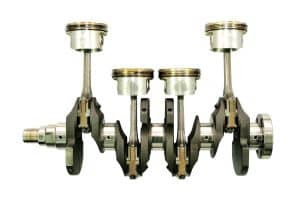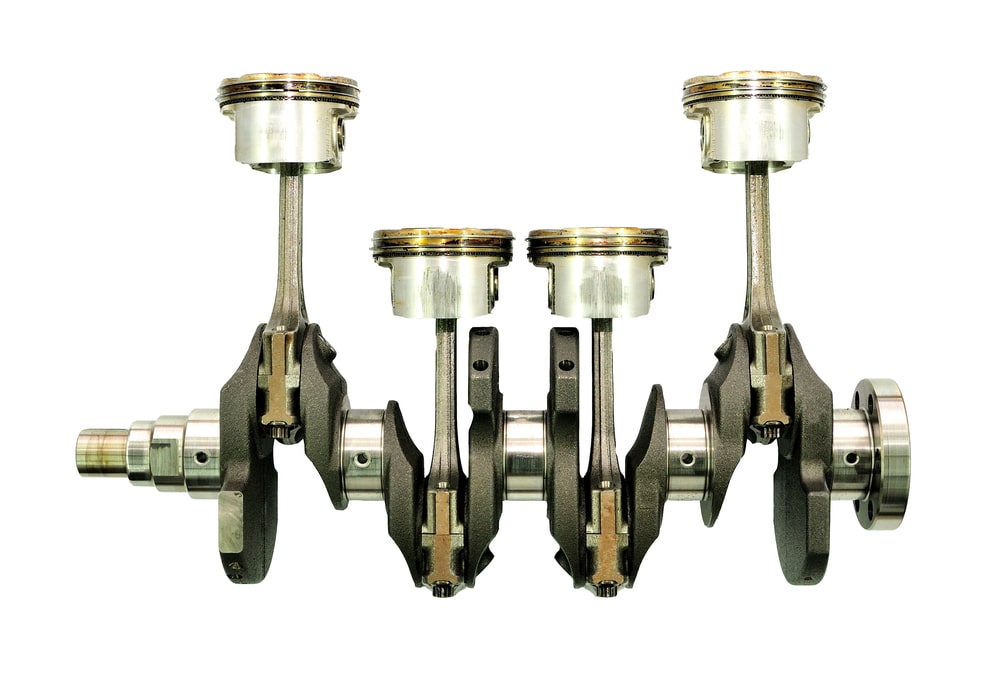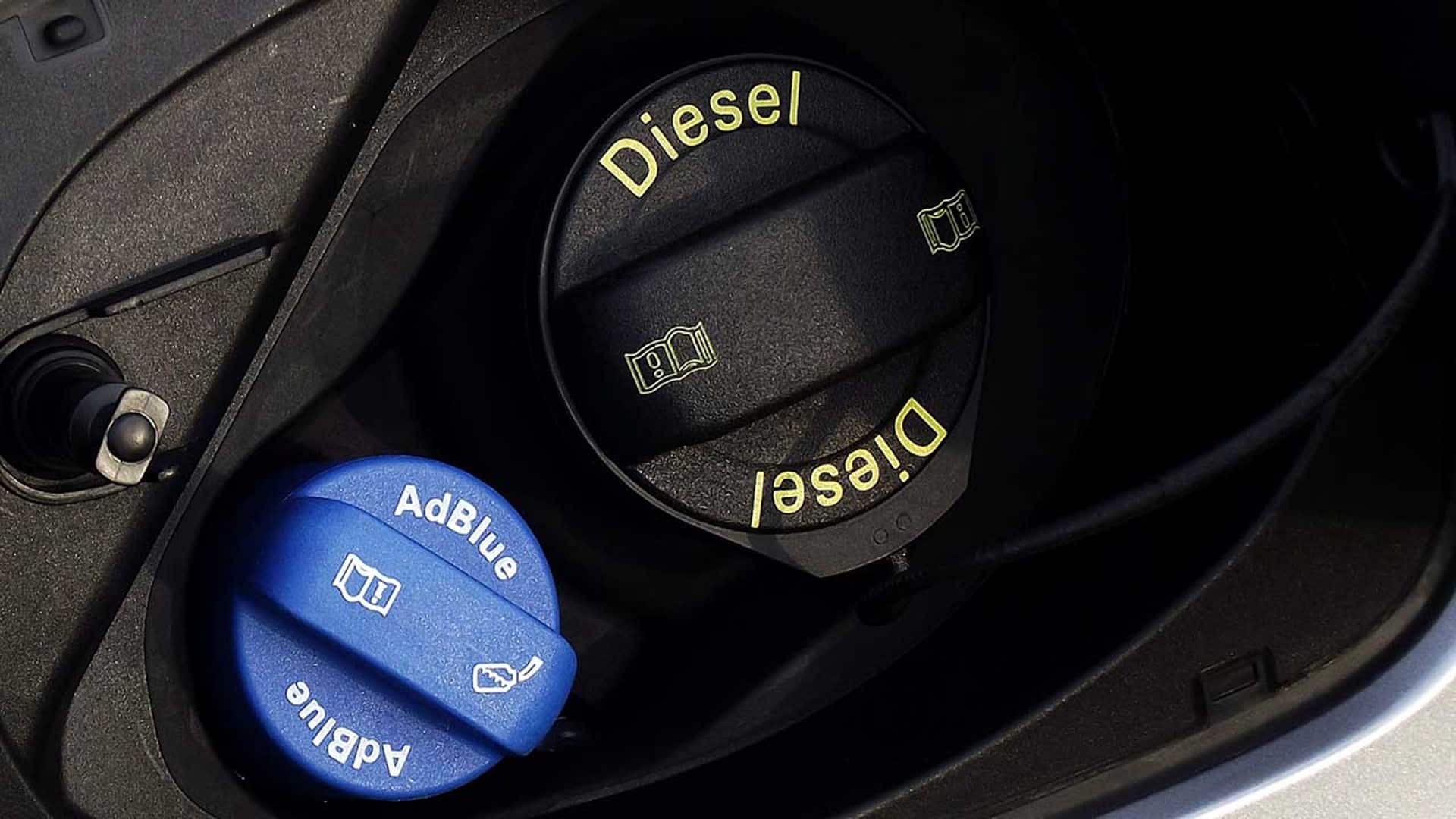Crankshaft
It’s buried deep in your engine, and you may well never heard of it, but your car wouldn’t move an inch without its crankshaft.
You don’t need to understand every engine component to maintain your vehicle correctly. However, a bit of knowledge about key parts can certainly come in handy, particularly when it comes to avoiding expensive repairs. This crucial engine component performs the essential job of converting your pistons’ up-and-down movement into the rotational force that ultimately powers your wheels. The good news? Crankshafts are engineered to last, but don’t take this component for granted – maintenance is still essential.
Whilst crankshaft failures aren’t common, your engine’s overall health depends largely on regular servicing. Regular oil changes using high-quality oil prevent premature wear, keeping everything functioning perfectly for years to come. So, whilst you shouldn’t need to worry about your crankshaft daily, staying up to date with your service schedule is absolutely essential.
In this guide, we’ll provide drivers in the Bedford, Hitchin, Letchworth and Stevenage areas with a simple overview of what the crankshaft and its position sensor do, why they’re vital, and how regular servicing at Cole & Miller Automotive protects both your engine and your finances.
Understanding the Crankshaft
The crankshaft is a precision-engineered part located in the lower portion of your engine block. It operates within a protected environment, the crankcase, with the oil pan situated beneath it to supply vital lubrication.
When examining a crankshaft up close, you’ll immediately appreciate its remarkable design complexity. It features carefully balanced counterweights to minimise vibration during operation, alongside precision-machined journals that serve as rotation points. Perhaps most crucially, it contains internal oil passages (called oilways) that allow oil to circulate through the component itself, protecting it against the tremendous forces it endures when the engine is running.
This internal lubrication system highlights precisely why top-quality oil and scheduled servicing aren’t optional luxuries; they’re absolute necessities. Should these vital passageways become starved of clean oil, the resulting metal-on-metal contact creates a destructive chain reaction: friction increases, temperatures rise dramatically, metal surfaces become scored, and complete engine failure can follow.

What Your Crankshaft Does
Your crankshaft performs a mechanical transformation, converting the pistons’ straight-line movement into rotational force. This turning motion transfers power through your clutch and gearbox before ultimately reaching your wheels. But that’s not its only job. The crankshaft also drives your camshaft via a timing chain, belt, or gear system, ensuring your valves open and close at precisely the right moments. Additionally, it powers numerous auxiliary systems through belt-driven pulleys, including your alternator, water pump, and air conditioning compressor.
Potential Issues
With proper maintenance according to your manufacturer’s recommendations, your crankshaft should remain trouble-free throughout your vehicle’s service life. Physical crankshaft damage is uncommon in well-maintained engines, though when it does occur, the consequences are typically severe, often requiring complete engine rebuilding or replacement.
In contemporary vehicles, issues with the crankshaft position sensor arise more frequently than problems with the crankshaft itself. This critical electronic component provides essential timing data that your Engine Control Unit (ECU) relies upon to operate. When this sensor fails, your engine simply cannot function properly, as the ECU lacks the information needed to coordinate ignition timing and fuel delivery.
Understanding the Crankshaft Position Sensor
The crankshaft position sensor represents a crucial part of your engine’s electronic management system. Mounted to your engine block, this sensor continuously monitors your crankshaft’s rotation, transmitting data about its precise position and rotational velocity to your vehicle’s computer systems.
Many modern engines depend entirely on this real-time position data. Your ECU requires this information to calculate exactly when to trigger spark plugs and activate fuel injectors within each cylinder. Without accurate position readings, the ECU essentially operates blindfolded, unable to synchronise these critical events with the engine’s mechanical cycle.
When this sensor malfunctions, the results are quickly noticeable. Your engine may stall unexpectedly or refuse to start altogether since the ECU cannot establish the crankshaft’s position. This makes the crankshaft position sensor a truly essential component in your car’s engine.
Red Flags: Your Crankshaft or Position Sensor Needs Attention
Be vigilant for these key warning signs that might indicate crankshaft or sensor problems:
- Check Engine Light – When your sensor begins providing inconsistent or interrupted signals, your vehicle’s ECU typically responds by illuminating the check engine light. This warning shouldn’t be ignored, as it often provides the earliest indication of a number of developing issues.
- Engine Performance Issues – Unpredictable engine behaviour may point to crankshaft sensor problems. You might experience misfiring cylinders as your ECU struggles to time ignition events properly. Many drivers notice a rough idle, with the vehicle shuddering when stationary. Performance degradation, particularly sluggish acceleration, can accompany these symptoms.
- Unusual Noises or Vibration – Distinct knocking sounds or excessive vibration whilst driving can suggest mechanical problems with the crankshaft itself. These symptoms require an immediate professional assessment to prevent further damage.
- Difficulty Starting – Your starter motor may turn the engine, but without position data, your ECU cannot determine when to initiate the combustion cycle. Interestingly, once running, your vehicle might continue operating despite sensor issues because the ECU can sometimes estimate crankshaft position based on previously established patterns. The problem typically reveals itself only after shutting down and attempting to restart.
- Temperature-Related Failures – Heat sensitivity often characterises failing crankshaft sensors. You might notice your vehicle operates normally during cooler morning drives but develops problems as the engine reaches operating temperature.
Prompt recognition of these symptoms can save you from extensive repairs. While identifying these warning signs can be challenging for non-specialists, acting quickly when they appear dramatically improves your chances of avoiding serious engine damage. We strongly recommend professional diagnostic testing at the first sign of any of these symptoms.
Keep Your Crankshaft Running Smoothly
Implementing these key maintenance strategies will help ensure your crankshaft remains in optimal condition throughout your vehicle’s lifespan:
Regular Oil Changes:
- Our technicians at Cole & Miller Automotive follow your manufacturer’s specific oil change intervals, preventing the accelerated wear that occurs when oil becomes contaminated or degraded.
- Fresh, clean oil delivers multiple benefits simultaneously: it provides essential lubrication to moving parts, carries away harmful particles that cause premature wear, forms a protective barrier against corrosion, and helps maintain optimal operating temperatures by conducting heat away from critical components.
Professional Servicing:
- Stick to your vehicle’s recommended service schedule. During these vital maintenance visits, our qualified technicians replace your oil, the importance of which shouldn’t be underestimated.
- These regular check-ups enable us to spot developing issues before they escalate into major failures, potentially saving you thousands in repair costs.
Quality Oil Selection:
- We never cut corners with generic lubricants at Cole & Miller Automotive. Instead, we exclusively use oils that meet or exceed your manufacturer’s specifications.
- Premium synthetic formulations provide superior protection for your crankshaft and bearing surfaces, particularly during cold starts when most engine wear occurs.
- Using the incorrect oil isn’t just bad practice; it can lead to accelerated wear and tear.
By following these straightforward maintenance principles, you’ll dramatically reduce your risk of unexpected breakdowns and costly engine repairs.
Trust Us to Take Care of Your Car’s Health
Following manufacturer-recommended maintenance isn’t just good advice; it’s essential protection for your vehicle. At Cole & Miller Automotive, we firmly believe that prevention is better than cure. Our approach to vehicle care has built our reputation as a trusted service provider across Bedford, Hitchin, Letchworth and Stevenage, earning us a 4.9 star Google rating from 200+ satisfied customers.
Choose our team and receive:
- Guaranteed use of manufacturer-specified or premium OEM replacement components for reliable, long-lasting repairs
- Outstanding value with transparent, no-surprise pricing on all services
- Access to specialist diagnostic equipment and tools for accurate assessment and repair
- Complete peace of mind with our comprehensive 12-month parts and labour guarantee on all work completed
Our experienced technicians deliver exceptional service by prioritising your vehicle’s long-term reliability and your personal safety on local roads.
Don’t gamble with your engine’s health. Call us today on 01462 730803 to discuss any crankshaft concerns, crankshaft position sensor issues or to arrange your next service appointment. Our friendly team is ready to help keep you safely on the road for years to come.


